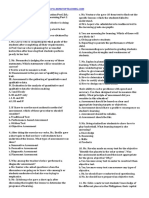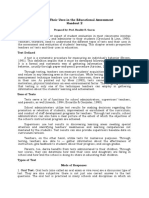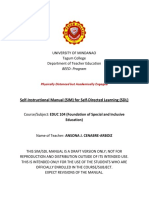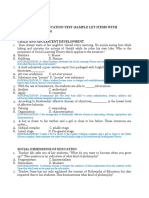Affective Domain of Teaching
Affective Domain of Teaching
Uploaded by
huwainaCopyright:
Available Formats
Affective Domain of Teaching
Affective Domain of Teaching
Uploaded by
huwainaOriginal Description:
Copyright
Available Formats
Share this document
Did you find this document useful?
Is this content inappropriate?
Copyright:
Available Formats
Affective Domain of Teaching
Affective Domain of Teaching
Uploaded by
huwainaCopyright:
Available Formats
AFFECTIVE DOMAIN IN TEACHING
Subscales
Teaching/Learning strategies
Intrinsic goal
orientation
Encourage students to set their own learning goals. Assign authentic tasks
that incorporate students personal interests and that show how to interpret
the familiar world around them. Emphasize understanding rather than
memorization of a topic. Highlight situational interest by displaying
enthusiasm for a topic, featuring novelty, variety, creativity or controversy
in lessons, have students role play within the context of lesson, or have
students manipulate physical models.
Extrinsic goal
orientation
Explain grading criteria and ensure exams reflect course goals. Give
students opportunities to practice with similar questions prior to exams.
Reinforce student confidence in their ability to master material through
notes or emails suggesting potential learning strategies and encouraging
students when they have done something well or shown significant
improvement.
Task value
Collect information on student interests and design assignments related to
those topics or to current events or sometimes to emotionally charged
events. Make explicit reference to the relevance of specific learning tasks
and the skills they involve for future personal or professional goals. Vary
the character of tasks to match different student learning styles and provide
sufficient time and support to ensure students have an opportunity to
successfully complete the task.
Control of
learning beliefs
Discuss initial MSLQ scores and provide feedback on how to improve
scores, model effective learning strategies in class, and explain that factors
such as effort often have more influence on student performance than prior
ability in science. Solicit student feedback about classroom practices or
give students opportunities to make choices about classroom rules, due
dates for some exercises, the format of assignments (e.g., essay vs. drawing
vs. concept map), or the components of a grading rubric.
Self-efficacy
Use scaffolding strategies that build complex knowledge upon a foundation
of more basic information and give formative assessments at each stage of
learning to confirm student understanding. Promote mastery of
challenging tasks through small-group activities. Provide students with
multiple opportunities to complete assignments by providing feedback on
drafts of papers or using testing strategies such pyramid exams. Remind
students that peers have had success on similar assignments and show
examples of successful peer models (e.g., as class tutors). Rewards should
be greater for more challenging tasks, few penalties for errors.
Test anxiety
Review test-taking tips with class, provide multiple opportunities to take
AFFECTIVE DOMAIN IN TEACHING
tests (from a larger question bank), offer partial credit for written
explanations for incorrect responses on multiple choice questions, and
provide supplementary learning opportunities (e.g., tutoring), teach
students specific study strategies.
Rehearsal,
Elaboration,
Organization
In-class formative assessment should model learning strategies. For
example, students could create mnemonics or make lists of key terms,
summarize key points or generate an outline of the text or lecture, respond
to conceptual multiple choice questions, or create a graphic organizer for
the class material (e.g., concept maps).
Metacognition
Encourage students to set specific learning goals for reading assignments,
model the use of rehearsal, elaboration and organization (e.g., writing a
summary sentence for each paragraph read), have students describe the
steps needed to solve a problem or complete an assignment, ask students to
reflect on specific learning experiences from other college classes.
Time/study
management
Have students develop specific study objectives and weekly study
calendars for the class, and ask them to track how they use their study time
during the week and on specific assignments. Encourage students to
consider and discuss the ideal environments for thinking, reading, or
writing tasks.
Effort regulation
Promote discussion of factors that interfere with learning and how to
overcome them. Encourage students to set specific study goals and have
them brainstorm on ways to avoid distraction.
Peer learning
Students are more motivated as part of a learning community than as an
individual in a class. Classes that employ informal or formal collaborative
groups to answer in-class assignments or to discuss materials covered in
lecture are more likely to foster motivation.
Help seeking
Hold a discussion on why students do or do not seek help. Describe helpseeking among faculty in research or review settings. Provide an
opportunity for students to analyze where they need help through meetings
with the instructor, graduate assistants, or undergraduate tutors. Instructors
should invite struggling students to consider seeking help.
You might also like
- Example of Anecdotal Observation RecordDocument2 pagesExample of Anecdotal Observation Recordhuwaina74% (19)
- PrEd 132n - The Teacher and The School CurriculumDocument9 pagesPrEd 132n - The Teacher and The School Curriculumshiela maeNo ratings yet
- Chapter 1 - EDCON1Document15 pagesChapter 1 - EDCON1hash moto100% (6)
- Lesson Plan StorytellingDocument2 pagesLesson Plan Storytellinghuwaina100% (1)
- T'boliDocument8 pagesT'boliAianna Paula Muñasque ParanNo ratings yet
- QUIZ - AffectiveDocument6 pagesQUIZ - AffectiveAnn Clarice0% (1)
- Assessment of Ones Teaching PracticeDocument27 pagesAssessment of Ones Teaching PracticeMarvin CayagNo ratings yet
- Module 2 - ENGLISH FOR INTERNATIONAL EMPLOYMENT 1Document18 pagesModule 2 - ENGLISH FOR INTERNATIONAL EMPLOYMENT 1ruthieann542100% (1)
- Ed 8 Midterm Exam (2023)Document6 pagesEd 8 Midterm Exam (2023)Frank Mecel Arzaga DimalantaNo ratings yet
- Notes in Educ 9 2Document24 pagesNotes in Educ 9 2jesvillaNo ratings yet
- The Teacher and The School CurriculumDocument40 pagesThe Teacher and The School CurriculumKenneth Aminulla100% (1)
- CLASSROOM MANAGEMENT by Jacob KouninDocument3 pagesCLASSROOM MANAGEMENT by Jacob KouninShaina jane Uy100% (2)
- Sim Educ 107Document136 pagesSim Educ 107Kim Henry MostralesNo ratings yet
- ProfEd 9 (The Teaching Profession)Document10 pagesProfEd 9 (The Teaching Profession)Mary Jane Dar EstiponaNo ratings yet
- Prof Ed With RationalizationDocument36 pagesProf Ed With Rationalizationnikkapantila02No ratings yet
- Curriculum Development: Pamantasan NG Lungsod NG MuntinlupaDocument4 pagesCurriculum Development: Pamantasan NG Lungsod NG MuntinlupaDesiree CaneteNo ratings yet
- Chapter 1.2 The Outcomes of EducationDocument10 pagesChapter 1.2 The Outcomes of EducationMikaela AltoNo ratings yet
- AssessmentDocument3 pagesAssessmentJoTanlogonOcate-AmbongNo ratings yet
- Proposed New Teacher Education Curriculum: CHED Technical Panel On Teacher Education Zonal Public HearingsDocument29 pagesProposed New Teacher Education Curriculum: CHED Technical Panel On Teacher Education Zonal Public HearingsjoycehalasanNo ratings yet
- EDU-052 ModuleDocument64 pagesEDU-052 ModuleAmery Colin Pagayunan LagartaNo ratings yet
- Course OutlineDocument4 pagesCourse OutlineKATHLEEN GO100% (1)
- Chapters 123Document41 pagesChapters 123Josenia ConstantinoNo ratings yet
- Educ 321: The Teacher and The School CurriculumDocument7 pagesEduc 321: The Teacher and The School CurriculumJericho AzulNo ratings yet
- Midterm Exam in Edtech 2Document2 pagesMidterm Exam in Edtech 2Crisvelle AlajeñoNo ratings yet
- Curriculum Development: I. Fundamental Concepts in CurriculumDocument18 pagesCurriculum Development: I. Fundamental Concepts in CurriculumPrincess Kyla Collado DelizoNo ratings yet
- Episode 1 Field Study 2Document4 pagesEpisode 1 Field Study 2sophia buiserNo ratings yet
- Handout 2 Test and Their Uses in The Educational AssessmentDocument5 pagesHandout 2 Test and Their Uses in The Educational AssessmentRizaldy GarciaNo ratings yet
- LET Reviewer Professional Education: Principles and Strategies of Teaching Part 1Document3 pagesLET Reviewer Professional Education: Principles and Strategies of Teaching Part 1Ed Doloriel MoralesNo ratings yet
- Final Exam Educ 2Document8 pagesFinal Exam Educ 2Marjorie MalvedaNo ratings yet
- Educ104 SIM - SDL EDITED PDFDocument130 pagesEduc104 SIM - SDL EDITED PDFNorienne TeodoroNo ratings yet
- Nature of Educational Assessment: What Do You Think Are Major Components in The Educational Process?Document22 pagesNature of Educational Assessment: What Do You Think Are Major Components in The Educational Process?DELA CRUZ KRISTINE Y.No ratings yet
- Cabellon CbarDocument21 pagesCabellon CbarAdi CabellonNo ratings yet
- PROF ED 7 - The Teacher and The School Curriculum: Talisay City CollegeDocument9 pagesPROF ED 7 - The Teacher and The School Curriculum: Talisay City Collegeelisha lasolaNo ratings yet
- Learning Activity 4Document1 pageLearning Activity 4Vanessa FilipinasNo ratings yet
- Lesson 4 Chapter 4F StudentsDocument34 pagesLesson 4 Chapter 4F StudentsShamaica SurigaoNo ratings yet
- The Teacher and The School CurriculumDocument9 pagesThe Teacher and The School CurriculumCarlo Petallar BuladacoNo ratings yet
- Facilitating LearningDocument4 pagesFacilitating LearningCamille MendozaNo ratings yet
- Principles and Strategies of TeachingDocument11 pagesPrinciples and Strategies of TeachingKa NaNo ratings yet
- Problem Center DesignDocument13 pagesProblem Center Designاحمد رجبNo ratings yet
- Assessment of Learning 2, Module 5Document5 pagesAssessment of Learning 2, Module 5Rheycarl Jay Aparicio100% (1)
- Unit I-Chapter 2 The TeacherDocument4 pagesUnit I-Chapter 2 The TeacherJane Tricia Dela Peña - NuquiNo ratings yet
- 4Document2 pages4Nel BorniaNo ratings yet
- Chapter 2Document15 pagesChapter 2Art BrandNo ratings yet
- Professional Education Test (Sample Let Items With Rationalizations)Document6 pagesProfessional Education Test (Sample Let Items With Rationalizations)Leona Jane BruceNo ratings yet
- Authentic AssessmentDocument46 pagesAuthentic AssessmentNicca A BorlagdanNo ratings yet
- Module 6 Prof Ed 103Document4 pagesModule 6 Prof Ed 103Gigi Man100% (1)
- Curriculum-Development - Process and ModelsDocument24 pagesCurriculum-Development - Process and Modelschazel mae andoNo ratings yet
- Chapter The Teacher and The School Curriculum Curriculum Essentials Module 1 The Teacher and The School Curriculum Module OverviewDocument25 pagesChapter The Teacher and The School Curriculum Curriculum Essentials Module 1 The Teacher and The School Curriculum Module OverviewQuinChiNo ratings yet
- The Teacher and The School Curriculum ReviewerDocument22 pagesThe Teacher and The School Curriculum ReviewerLlego, Rhiomeiza A.No ratings yet
- Module 6 - Lesson 1 - RefineDocument8 pagesModule 6 - Lesson 1 - RefineNOCKSHEDELLE POCONGNo ratings yet
- Chapter 03Document21 pagesChapter 03Laiba Naeem100% (1)
- Prof ED W AnswersDocument9 pagesProf ED W AnswersJane Magsombol Pujante LptNo ratings yet
- Quiz in NcbtsDocument15 pagesQuiz in NcbtsArjay LauretaNo ratings yet
- Teaching Prof ReportDocument15 pagesTeaching Prof ReportLaleth Mendoza Ojales100% (6)
- Type of Curriculum Design in K To 12 Illustrative Examples: Subject-Centered Design/ApproachDocument1 pageType of Curriculum Design in K To 12 Illustrative Examples: Subject-Centered Design/ApproachJonalyn Murillo LundagNo ratings yet
- Elements and Components of CurriculumDocument45 pagesElements and Components of Curriculumconnie batucanNo ratings yet
- Enhanced General Education SubjectsDocument11 pagesEnhanced General Education SubjectsLawrence BucayuNo ratings yet
- A Paradigm Shift For 21st Century EducationDocument1 pageA Paradigm Shift For 21st Century Educationpalenaubrey100% (1)
- Testing Event Formative Summative: Name: Date: Year and Section: Instructor: Module #: TopicDocument9 pagesTesting Event Formative Summative: Name: Date: Year and Section: Instructor: Module #: TopicMarsha MGNo ratings yet
- Activity 1Document3 pagesActivity 1Joshua BaguioNo ratings yet
- Affective Learning - Assessment ofDocument58 pagesAffective Learning - Assessment ofJowel VistaNo ratings yet
- My Teacher is My Hero: Tributes to the People Who Gave Us Knowledge, Motivation, and WisdonFrom EverandMy Teacher is My Hero: Tributes to the People Who Gave Us Knowledge, Motivation, and WisdonNo ratings yet
- Music Education For Young ChildrenDocument7 pagesMusic Education For Young Childrenhuwaina100% (1)
- Simple Trip EssayDocument1 pageSimple Trip Essayhuwaina100% (2)
- Presentation1 - Assessment Evaluation - PPT 2Document69 pagesPresentation1 - Assessment Evaluation - PPT 2huwainaNo ratings yet
- Senarai Tajuk Buku Pendidikan Awal KanakDocument28 pagesSenarai Tajuk Buku Pendidikan Awal KanakhuwainaNo ratings yet
- Folklore CharacteristicsDocument11 pagesFolklore CharacteristicshuwainaNo ratings yet
- Turn Back The Hands of TimeDocument11 pagesTurn Back The Hands of TimehuwainaNo ratings yet
- How To Write A Research ProposalDocument5 pagesHow To Write A Research Proposalhuwaina100% (1)
- Music Education For Young ChildrenDocument6 pagesMusic Education For Young ChildrenhuwainaNo ratings yet
- Music Education For Young ChildrenDocument9 pagesMusic Education For Young ChildrenhuwainaNo ratings yet
- 145 - Fine Motor Milestones PDFDocument2 pages145 - Fine Motor Milestones PDFhuwaina100% (3)
- Finger Puppet Insect ButterflyDocument14 pagesFinger Puppet Insect ButterflyhuwainaNo ratings yet
- Philosophy Reggio EmiliaDocument5 pagesPhilosophy Reggio EmiliahuwainaNo ratings yet
- Reggio Emilia SlideDocument3 pagesReggio Emilia SlidehuwainaNo ratings yet
- Assessment and EvaluationDocument8 pagesAssessment and EvaluationhuwainaNo ratings yet
- Criteria Prsentation RubricDocument2 pagesCriteria Prsentation RubrichuwainaNo ratings yet
- Final Parent Involvement Fact Sheet 14732 7Document4 pagesFinal Parent Involvement Fact Sheet 14732 7huwainaNo ratings yet
- Does Early Care Help Children or Hurt Children JournalDocument55 pagesDoes Early Care Help Children or Hurt Children JournalhuwainaNo ratings yet
- Normal Stages of Human DevelopmentDocument5 pagesNormal Stages of Human DevelopmenthuwainaNo ratings yet
- Debate Children IssuesDocument3 pagesDebate Children IssueshuwainaNo ratings yet
- Affective Domain of TeachingDocument2 pagesAffective Domain of TeachinghuwainaNo ratings yet
- Role-Play Project PaperDocument3 pagesRole-Play Project PaperhuwainaNo ratings yet
- DepEd Order NoDocument4 pagesDepEd Order NoEjhay Rodriguez0% (1)
- Professional Communities Hord2009Document4 pagesProfessional Communities Hord2009api-356854001No ratings yet
- SLP 5r1Document3 pagesSLP 5r1api-256632895No ratings yet
- Asl Part1Document4 pagesAsl Part1Skye Lucion73% (15)
- Chapter 01Document23 pagesChapter 01UB MalikNo ratings yet
- School Excellence FrameworkDocument15 pagesSchool Excellence Frameworkapi-290054811No ratings yet
- Jamie OutDocument1 pageJamie OutJamie OutNo ratings yet
- Grade 9 Geography Term 2 Lesson PlansDocument19 pagesGrade 9 Geography Term 2 Lesson Plansabdulwahad298No ratings yet
- Gas Powerpoint 2010Document29 pagesGas Powerpoint 2010api-265973793No ratings yet
- After Teaching Reflection - PoetryDocument2 pagesAfter Teaching Reflection - Poetryapi-239699502No ratings yet
- Cultural Dimensions of Climate Change Impacts and AdaptationDocument6 pagesCultural Dimensions of Climate Change Impacts and AdaptationpejzazNo ratings yet
- Small Group: Action PlanDocument1 pageSmall Group: Action Planapi-392409478No ratings yet
- Recycling Project RecyclingDocument4 pagesRecycling Project Recyclingapi-404772398No ratings yet
- Formative Assessment 2Document16 pagesFormative Assessment 2Mohammad Nurul AzimNo ratings yet
- TOOL PRESEENTATION AkanshaDocument8 pagesTOOL PRESEENTATION AkanshaAkansha JohnNo ratings yet
- Problem SolvingDocument19 pagesProblem Solvingapi-202207322100% (1)
- Jurnal Pendidikan Ipgktar 2015Document161 pagesJurnal Pendidikan Ipgktar 2015pena daieNo ratings yet
- Cover Letter-Updated v8Document2 pagesCover Letter-Updated v8Veasna ChannNo ratings yet
- Incidence (Epidemiology)Document3 pagesIncidence (Epidemiology)Muhammad Bilal SiddiquiNo ratings yet
- Test Inteligencia Emocional Adaptado EspañolDocument7 pagesTest Inteligencia Emocional Adaptado EspañolGer RubiaNo ratings yet
- L Kibbe ResumeDocument2 pagesL Kibbe Resumeapi-256541406No ratings yet
- Danielle Mignella ResumeDocument2 pagesDanielle Mignella Resumeapi-219950997No ratings yet
- BAEI POB Technology and Global Business EnvironmentDocument11 pagesBAEI POB Technology and Global Business EnvironmentAdelia WatkinsNo ratings yet
- School ID Region VIII Division District School Name School Year SectionDocument36 pagesSchool ID Region VIII Division District School Name School Year SectionVersoza NelNo ratings yet
- Rosita Scerbo Resum 11-09-2014Document3 pagesRosita Scerbo Resum 11-09-2014api-270307903No ratings yet
- CHD 145 Lesson-Plan-Hand-WashingDocument2 pagesCHD 145 Lesson-Plan-Hand-Washingapi-285074574100% (1)
- 4 5794063688650458543 PDFDocument117 pages4 5794063688650458543 PDFAbdelmajeed AzhariNo ratings yet
- Early Intervention For Children With Intellectual Disabilities: Nigeria PerspectiveDocument5 pagesEarly Intervention For Children With Intellectual Disabilities: Nigeria PerspectiveIOSRjournalNo ratings yet
- Research TopicDocument6 pagesResearch TopicKitz Tanael100% (1)
















































































































